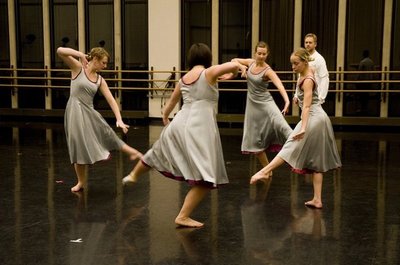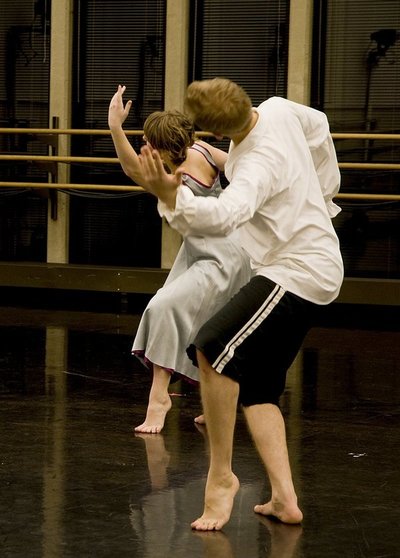December 3, 2009
Modern dance and period music mix in the Faculty Dance Concert’s ‘Brahms Waltzes’
The title Brahms Waltzes may bring to mind ladies in long dresses whirling around the dance floor in the arms of tuxedo-clad men, but that isn’t what viewers will see when the dance is performed as part of the Faculty Dance Concert this weekend. True, the four female performers will be wearing gray satin dresses with purple petticoats, but their feet will be bare, and there’s only one male dancer to serve as a partner.
Brahms Waltzes is a restaging of a 1961 work by Charles Weidman. The music is indeed a series of waltzes by Johannes Brahms (1833-1897), but the dancing is distinctly modern. Weidman was one of the pioneers of modern dance, and he created this particular dance as a tribute to Doris Humphrey, his longtime artistic partner, after her death. When he presented it, he always included the following quote in the program notes:
“Dedicated to Doris Humphrey because it was the kind of movement she loved and could dance so beautifully.”
That quote will also be in the program for the Faculty Dance Concert, an annual event that features undergraduate dancers performing mostly work by faculty in the Dance Program. Performances are Thursday, Dec. 3 through Sunday, Dec. 6, in Meany Studio Theater.
Brahms Waltzes is an exception on the program. Dance Professor Betsy Cooper obtained an Arts and Sciences Exchange Grant to bring Weidman expert Deborah Carr to campus last summer. Carr taught Weidman-Humphrey techniques to UW dance students and set two Weidman works — Lynchtown on the graduate student Chamber Dance Company and Brahms Waltzes on undergraduates. Lynchtown was seen in the CDC concert in October.
There are 16 waltzes, varying in length and tempo, in the Brahms Waltzes piece, Cooper said — about 18 minutes in all. “Because of the music there’s a lyricism to the choreography,” she said.
But there’s also a certain amount of athleticism. “One of the things Doris Humphrey was famous for in her technique was what we call fall and recovery,” Cooper said. “So how does the dancer suspend herself for a moment before she goes into a back fall or a side fall. Humphrey called this the death between two arcs. She was really interested in what happens in the body in this place between being vertical or being in a jump and falling to the floor — this moment of suspension, this moment of breath.”
The technique is new for most of the dancers. “It takes a bit of getting used to, said Consuelo Palmer-Bormann. “Sometimes it feels as if you are really falling and will crash, but Deborah said that that was the feeling we had to feel to get the technique right. When you get used to it, it creates a sense of freedom in your movements, a sense of suspense and drama that makes dance more exciting to watch.”
Each individual waltz in the piece has its own choreography. One of them, which Weidman titled Eyes, is an improvisation.
“It’s still a waltz, and the only direction Weidman gave in this is that the dancers had to initiate any movement they did with a focus,” Cooper said. “So they had to look at something and see something first, and whatever they saw — and they’re using their imaginations to do this — would lead them to move. So they might look up, and they might be lying down on the floor, then get up and walk to a place. What I’ve noticed in rehearsals in this improv section is that the whole cast — and they range in age from 18 to 48 — all become very childlike. It’s like they’re playing, because it’s imaginary.”
Re-creating historic works like this one is a staple of the Chamber Dance Company, which is made up of graduate students. But undergraduates in dance get fewer such opportunities. “We thought this piece would be really wonderful for our students to do because we are 80 years away from the beginning of modern dance,” Cooper said. “It’s a really important part of the students’ education to be exposed to this historic modern dance work.”
Sharing the concert program with Brahms Waltzes are new pieces by faculty choreographers Jennifer Salk, Jurg Koch and Juliet McMains, as well as work by alums Francisco Gella, Louis Gervais and Rhonda Cinotto. All performances are in the Meany Studio Theater. Tickets are $18, $16 for UW faculty, staff and alumni association members and $10 for students and seniors. They are available at the Arts Ticket Office, 206-543-4880, or on the Web at www.meany.org.




